Overall concept
The break-junction technique was established by measurements on single-molecule layered films (till 2000: First Stage), resulting in the quantitative analyses (till 2012: Second Stage). The study on the measurement of the electrical conductivity of single molecules has now reached the Third Stage, where challenging efforts are made to achieve the desired functions by overcoming several disadvantageous aspects of molecules, such as thermal instability and fluctuations; this is accomplished by organizing the molecules into a group to overcome the damages and malfunctions of individual molecules, and through cooperative phenomena.
In this field, an accurate molecular design and a structural design of an electrode surface will lay the foundation for creating switching functions, using light, electric fields, and magnetic fields. Instead of randomly integrating single-molecule devices that possess such functions, a system for proactively utilizing the fluctuations and variations in the current signals is orchestrated for realizing signal processing by cooperative actions of numerous molecules.
The phrase “Molecular Architectonics” refers to the manifestation of electronic, optical, and information-processing functions that are orchestrated by molecular assemblies like pillars and beams in a building structure. The researchers will participate as “molecular architects,” in the “design” and “fabrication” processes, to elaborately design a procedure for the determination of the position of pillars (molecules) on the foundation (surface), for creating organisms .
The implementation of the fundamental strategy initiates with the creation of “Design Drawing” and the “Design Concept” (architecture). The most important topics involve: designs of the molecules that will form the “pillars and beams,” close examinations and improvements of the designs (Research Topic of Group A01), designs of the surface that will form the “foundation,” the detailed inspections and property modifications (Research Topic of Group A02), designs for connecting a molecule with another (pillars and beams), inspections and structural modifications (Research Topic of Group A03) . Furthermore, new methodologies and guidelines for structural design or function manifestation through cooperative efforts will be developed by proactively incorporating thermal instability and structural fluctuation into the signal process to ensure that the “building structure” is harmonious and withstand earthquakes (Research Topic of Group A04).
A01 Precise molecular design and synthesis
| A single-molecule electronics material and a functional organic compound intended for achieving an integrated functional material will be synthesized by accurately designing and utilizing organic transformation methods. Practical targets include: 1. the molecular design (collaboration with the Yoshihiro Asai Group) and the synthesis of functional units, which is expected to provide single molecules with new functions, will be performed by the integration of higher orders. The electrical characteristics of such single molecules will be measured (collaboration with the Tada Group) and the higher function manifestations will be made possible through their integration; this will be substantiated by conducting multiple-probe measurements using carbon nanotube (CNT) electrodes and similar materials (collaboration with the Kazuhiko Matsumoto and Hasegawa Groups). The molecular structure for achieving the desired functions based on other groups will also be designed and synthesized. A joint study with the Tetsuya Asai Group will enable the integration of these materials in the search for new possibilities of information-processing methods. 2. The anchor unit with the metal electrode, which are essential to achieve the single-molecule electronics, and the conductor wire unit that is responsible for electric conductivity will be developed to elucidate the local electronic conditions in the charge transport and the metal electrode–organic molecule interface. Furthermore, the study will focus on developing functional single-molecule electronic materials with photo-electrical conversion functions, for the purpose of realizing a single-molecule nanoelectronics energy conversion. For example, the attachment of organic molecules and electrodes composed of CNTs will be essential for the evaluations of methods to achieve integration. Therefore, the anchor unit suitable for such a connection will be developed. 3. Organic synthesis technologies (the area of expertise for our research groups) will be utilized to synthesize chemical compounds. These will be used to clarify the electronic physical property conversions occurring in association with the molecular conversion reactions in which a π-electronic system is fused because of external stimuli, such as heat and light, and the physical properties of molecular aggregates generated in the molecular conversion process by using multiple-probe measurements based on such fundamental properties (collaboration with the Matsumoto and Hasegawa Groups). These will be then transformed into single-molecule devices (collaboration with the Ogawa and Ie Groups) to evaluate the electrical characteristics of single molecules (collaboration with the Tada Group). A high degree of purity has been achieved for highly conjugated compounds, such as polyacenes, benzoporphyrins, and boron dipyrromethanes, through the π-electronic ring-fusion reactions; OFET and OPC have been successfull prepared using specific field-conversion methods. The device performances are significantly affected by the electrical characteristics of the fundamental π-electronic systems and the integration modes of the molecules. The effects of the π-electronic integration mode are clarified by generating aggregates with varying integrated morphologies, by employing conversion reactions on a substrate while controlling the external stimulus and measuring the electrical properties. Furthermore, the fundamental π-electronic system is measured by fabricating single-molecule devices. 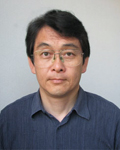 Group leaders |
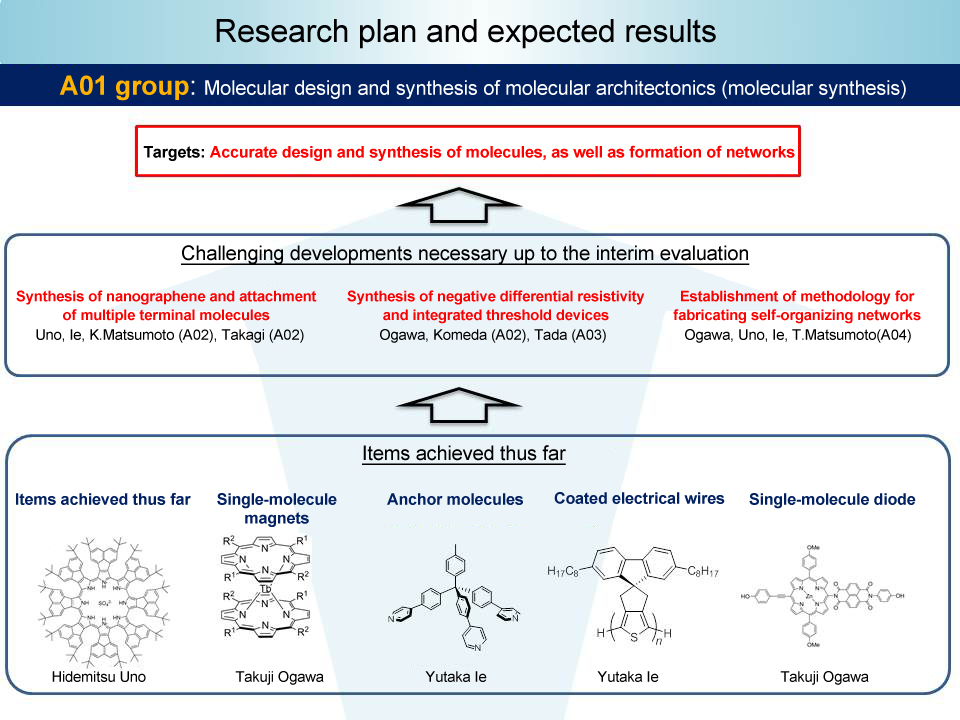 |
Research Topics
|
|
A02 Designing and Formation of Surface and Interface for Molecular Architectonic
This research group will investigate the electronic conditions of the surfaces of metals, semiconductors, and insulations, as well as the attached molecular components to derive the design guidelines for the two-dimensional components, necessary for building molecular architectures, by studying other research topics. Necessary items: the connection mode of the connecting interface of electrodes and molecules are extremely important for carrier and spin injections, and the interfacial control technology can be appropriately described as the key to the commercialization of organic EL . Single molecules are more sensitive to interfaces, and the electrical characteristics are known to vary depending on the difference in the connection positions by half the atomic size. Therefore, this research group has a significant role. Personnel: Yoneda (A02-1) will be in charge of clarifying the origin of the abnormal spin conditions that occur in the interface between a single-molecule magnet and a metal, as well as the interface design through molecular manipulations. Takagi (A02-4) will employ a scanning tunnel microscope (STM) and the “laser multiphoton ionization and photoelectron spectroscopy” to study the functional surfaces with chemically-modified metals and insulators, silicene surface of two-dimensional silicon networks, as well as electron-electron structure and vibrational structure of hetero-interface generated by fixing a molecule on a silicene surface at a low temperature in a strong magnetic field. Matsumoto (A02-3) will connect the molecules to 14 group networks in order to control the characteristics of electrical conductivity by using sensing function. He will also fabricate a stochastic resonating device to provide the support for the promotion of study conducted by A04. The three groups described above will more or less encompass various surfaces; however, the collaboration will be sought with the publicly recruited research groups in order to utilize new interfaces. Ishida (A02-2) will clarify the detailed single-electron structure in the molecules and heterostructure of the surface by performing density functional calculations of the semi-infinite crystal, according to the embedded green-function equation, to provide a guidance for the interfacial design.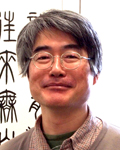 Group leaders |
 |
Research Topics
|
|
A03 Design and measurement of molecular function
The conductivity and transport properties at the single-molecule level prior to the networking will be evaluated, and the information will be utilized to set up the guidelines for functional design. The interactions between the single molecules via the substrates and support media (base, pillars, and beams) at the time the single molecule is incorporated into the network, as well as the effect on the conductivity and transport function will be clarified to establish the theoretical foundation of molecular architectonics simultaneously. The non-linearity (non-ohmicity) with strong current and voltage characteristics can be considered as one of the most significant characteristics of electrical conductivity occurring via a single molecule. The current characteristics depend largely on the molecular structure and can also result in strong rectifying effects (asymmetry of current and voltage characteristics) and memory functions. Another significant characteristic is the electric conductivity fluctuation arising from the variation in the molecular orientation and junction structure as well as quantum effects. Group A03 will study this issue from the beginning for clarifying the substantial material parameters that finely provide the nonlinear transport characteristics and fluctuations from both theoretical and experimental aspects.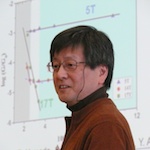 Group leaders |
 |
Research Topics
|
|
A04 Design and measurement of cooperative functions
We design, implement, and characterize the synergetic functions in nonlinear element networks for molecular architectonics. The group will derive a new methodology and structural design guideline to exhibit cooperative functions for informatics exploiting fluctuations of molecules, rather than removing and suppressing them. Our basic strategy for such purpose is to utilize bio-inspired phenomena in nonlinear systems such as “stochastic resonance”, in which the response of the system is optimized or enhanced by noise, for example. We design single molecular networks, characterize the carrier transport and fluctuation in them, cause the stochastic resonance. We also design the nonlinear element network and characterize its responses. To find appropriate mechanism and establish technology for implementing information processing functions in the single molecular network, we extensively collaborate with groups A01, A02, and A03 in terms of molecular designing, synthesizing, and measurement. We integrate them with our knowledge and technologies of the nonlinear transport in nano-scale, stochastic resonance, nanodevice integrated circuit, and brain-inspired information processing architecture.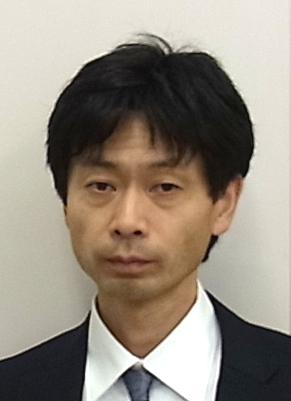 Group leaders |
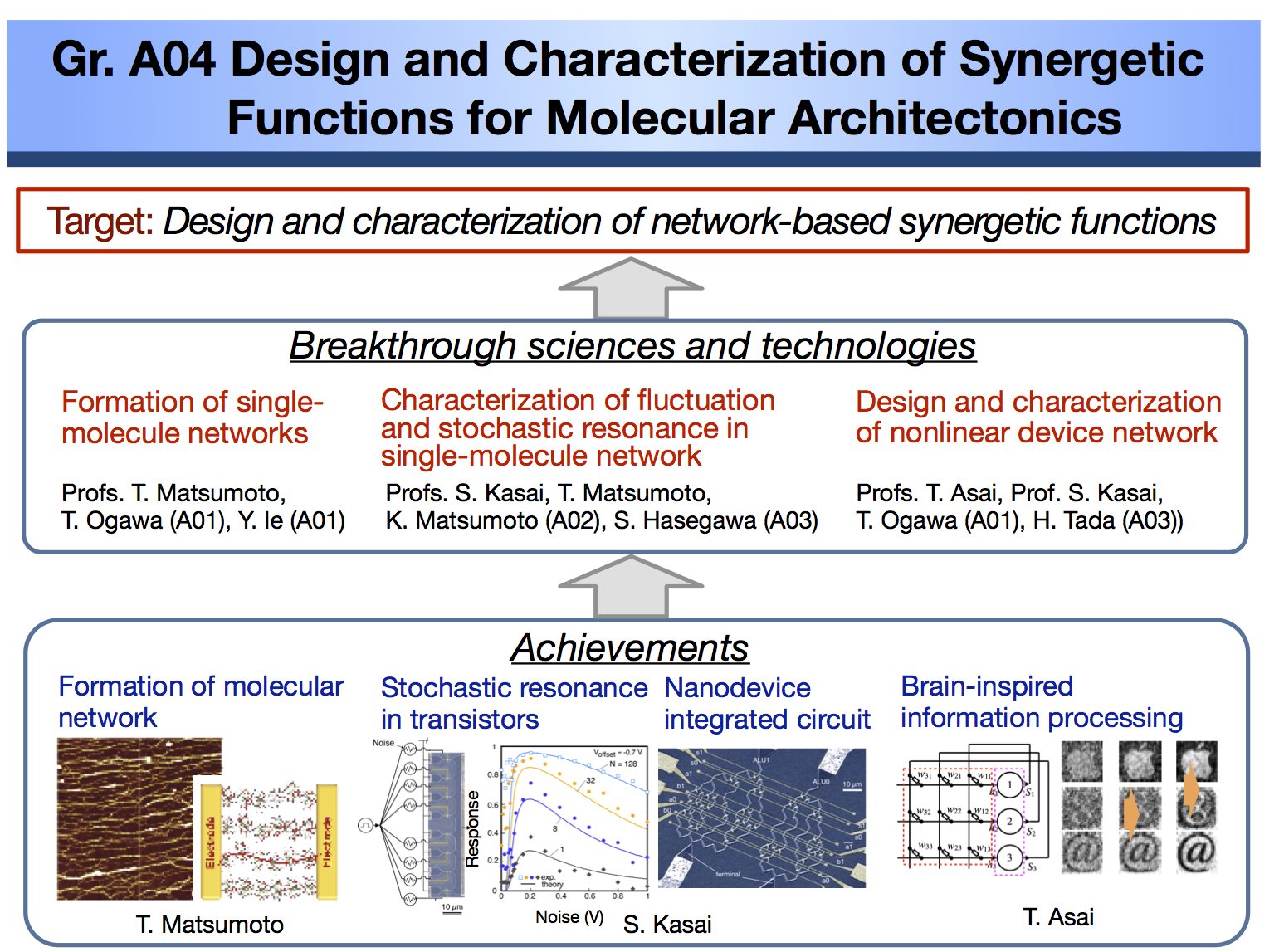 |
Research Topics
|
|
